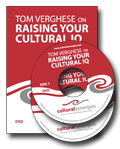| The Cultural Synergist - Issue 15 April 2009 |
|
|
Welcome to The Cultural Synergist |
| Hi ,
Welcome to the Cultural Synergies April 2009 newsletter.
Kind regards
The Cultural Synergies Team
April 2009
|
|
|
Effective Videoconferences
|
|  This is a follow up to last month�s newsletter on effective teleconferences. As mentioned then, with the current global financial crisis, there has been a reduction in travel and a big increase in the number of teleconferences and video conferences (VC). This month I would like to talk about how to be more effective with VC�s. This is a follow up to last month�s newsletter on effective teleconferences. As mentioned then, with the current global financial crisis, there has been a reduction in travel and a big increase in the number of teleconferences and video conferences (VC). This month I would like to talk about how to be more effective with VC�s.
For a start, imagine leading a VC as being on TV - interactive TV! As compared to a teleconference, people can actually see you and you can see them with this medium (this can either be a good thing or not!).
A VC is more expensive then a teleconference so the outcomes need to be better; especially if you choose to use an external party�s equipment. Bandwidth is critical for good transmission, if you don�t have enough then there is delay in the transmission and you come across as very stilted. There is some very impressive technology available now that makes it seem like you are all in the same room and very �real� eg Telepresence from Dell and halo from HP.
Similarly to the discussion on teleconferences, let�s break a VC into three sections � before, during and after!
Before the Conference
- Establish the purpose of the VC - what are the objectives and outcomes you want to achieve?
- Are you going to use your own equipment or go off site and use a third party's?
- If you are leading the VC, then have someone else work the equipment so that you can focus on the meeting rather than the technology.
- How many sites will be involved? Assign someone to handle the technology at those sites. How will you plan to involve them in the meeting?
- You may want to consider your attire � patterns and stripes tend not to be clear in a VC, so plain or bold colours tend to work better. Watch your TV news presenters for ideas on what works regarding clothes and colours.
- Prepare an agenda with rough time-frames so that you can keep track.
- Send out any slides/pre-reading material beforehand and communicate expectations that they be read beforehand so that the meeting time is used as an opportunity to discuss.
- Plan for who is going to attend. Consider have they met beforehand, do they all know each other, what are the dynamics of the group etc. Anymore than 6-8 at a location becomes difficult to manage if you want interaction.
- Plan where and when you will get group input during the meeting.
- Rehearse the opening and first few minutes.
- If you are leading the meeting, then appoint someone to manage the equipment. Get some mental clarity at least 10 minutes before you start (if you are leading it) so you are focused rather then getting focused as you move into it.
During the Videoconference
- Start on time.
- Go around the room and get everyone to check in � � minute each on what�s happening at their location. Discussion of the weather, current affairs, and highlights can act as icebreakers. Focus on the humanness before the task.
- Name tags (16 point font) are a good idea if people are meeting for the first time.
- Provide an overview of the agenda and objectives of the meeting.
- Have the �technical� person work the camera so that it can be zoomed in to the speaker to maximize on facial expressions.
- Be succinct in speech, conscious of your speed, voice modulation,and pronunciation, as well as being conscious of your body language.
- Be aware of language differences, accents and time-zones.
- Invite quieter people in.
- Agree on action steps if any, timelines etc.
- Go around the room on completion and check out.
After the Teleconference
- Follow up with individuals if there were issues that needed to be covered.
- Does a summary report need to be created with action steps, due dates etc?
- Evaluate the success of your VC against the objectives that you set at the start.
- Reflect on how you can become more effective in using this medium.
If you would like a free copy of a Teleconference/Videoconference checklist go to 'Articles' on our 'Resources' page at : http://www.culturalsynergies.com/resources.htm
|
|
|
|  Transnational Leadership Development: Preparing the Next Generation for the Borderless Business World. Fisher-Yoshida & Geller (2009) AMA Books. Transnational Leadership Development: Preparing the Next Generation for the Borderless Business World. Fisher-Yoshida & Geller (2009) AMA Books.
This is a newly released book. Both authors are experienced consultants who work with multinational organizations across the globe.
The authors differentiate between �transnational leadership� and �international leadership�; claiming that to be an effective transnational leader, you need to be culturally agile and view cultural differences as paradoxes rather than problems. There are five paradoxes that are discussed and each paradox includes provocative questions that encourage the reader to think more deeply about some of the challenges that transnational leaders may face.
The models and approaches are useful tools that can assist leaders to see, learn, feel and experience the world through different lenses. The book offers some great strategies for finding new ways to communicate and for increasing resilience when things aren�t going quite �your way�. It also includes some great practical tools.
|
|
|
NEW PRODUCT - 'Tom Verghese on Sourcing Across Cultures'.
Cultural Synergies would like to thank all of our supporters for the great response we had to our DVD and CD launch.
If you would like to find out more and purchase a DVD or CD please go to
http://www.culturalsynergies.com/store.htm
|
|
|
|  'Raising Your Cultural IQ - New DVD and CD 'Raising Your Cultural IQ - New DVD and CD
'Raising Your Cultural IQ' explores the issues around culture, the challenges that culture can pose and provides some great strategies on how to leverage on cultural differences and similarities.
 'The Invisible Elephant - Exploring Cultural Awareness', 2nd Edition by Tom Verghese 'The Invisible Elephant - Exploring Cultural Awareness', 2nd Edition by Tom Verghese
Many aspects of culture are invisible, yet culture has an enormous impact on our lives. Like an Invisible Elephant, if ignored these aspects can lead to misunderstanding, stress and conflict. Alternatively, if attention is given to the Invisible Elephant, it can enhance productivity, improve teamwork and create more joy in our lives.
Book testimonial by Asma Ghabshi, Learning And Development Manager, Shell Oman:
"The Invisible Elephant made my perspective of my national culture in comparison to my personal culture more visible. It has given me a deep insight into dealing with people of different cultural backgrounds."
 'Pillars of Growth - Strategies for Leading Sustainable Growth' - Book by Tom Verghese, Kerry Larkan, Steven Howard and Brad Tonini 'Pillars of Growth - Strategies for Leading Sustainable Growth' - Book by Tom Verghese, Kerry Larkan, Steven Howard and Brad Tonini
Written with the business leaders and entrepreneurs of Asia in mind, 'Pillars of Growth' provides a road map to assist you in thinking through four critical concerns that impact the sustainable growth of every business.
Visit our store at www.culturalsynergies.com/store.htm
|
|
|
About Cultural Synergies
Cultural Synergies' mission is to improve individual and organisational performance when interacting with people across the globe. Take advantage of our years of international experience. All our services are tailored to individual client situations. Visit our website www.culturalsynergies.com for more information.
Phone: +61 3 9654 6161 | Mobile: +61 (0) 419 999 292 | Fax: +61 3 9650 7350
Email: enquiries@culturalsynergies.com
Privacy Policy
You are receiving this newsletter from Cultural Synergies because you are on our email list. To ensure that you continue to receive emails from us, please add my email address to your address book today. Cultural Synergies respects your right to privacy. We never share, rent, or sell your name or email to anyone else. Your privacy is safe with us. |
|
|
| |
|
